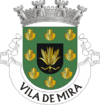Mira, Portugal
| Mira | |||
|---|---|---|---|
| Municipality | |||

A view of the municipal seat of Mira
|
|||
|
|||
 |
|||
| Coordinates: 40°26′N 8°44′W / 40.433°N 8.733°WCoordinates: 40°26′N 8°44′W / 40.433°N 8.733°W | |||
| Country |
|
||
| Region | Centro | ||
| Subregion | Baixo Mondego | ||
| Intermunic. comm. | Região de Coimbra | ||
| District | Coimbra | ||
| Parishes | 4 | ||
| Area | |||
| • Total | 124.03 km2 (47.89 sq mi) | ||
| Population (2011) | |||
| • Total | 12,465 | ||
| • Density | 100/km2 (260/sq mi) | ||
| Time zone | WET/WEST (UTC+0/+1) | ||
| Website | www.cm-mira.pt | ||
Mira (Portuguese pronunciation: [ˈmiɾɐ]) is a municipality in the central Portuguese district of Coimbra. A coastal municipality, known for its beaches, forests, and agriculture, the population was 12,465 inhabitants in an area of approximately 124.03 square kilometres (47.89 sq mi).
In 1442, the regent Peter, Duke of Coimbra, conceded administrative autonomy to the town of Mira.
Concession of its first Foral (charter) occurred almost a century later, during the reign of King D. Manuel I. At that time, on 28 August 1514, the king bestowed to Gonçalo Tavares, the first seigneur of Mira, privileges to develop the region.
In 1644, by royal concession, King D. John IV of Portugal transfer donatário title to the Casa da Rainha referring to the older concession, bestowed further rights to his successor, Manuel de Sousa Tavares (from the Memórias Paroquiais).
Mira was integrated in to the bishopric and comarca of Coimbra in 1758.
Administratively, the municipality is divided into 4 civil parishes (freguesias):
A centre for artisanal fishery, and aquaculture, Mira's economic activities also rely on agriculture, forestry, and tourism.
In 2007, the Galician fishing company Pescanova, headquartered in Redondela, Spain, announced its intention to build several sea bass aquaculture plants in Mira. Pescanova invested about 350 million Euros in the Portuguese aquaculture plant, which was backed by the Portuguese government with about 45 million Euros in incentives. The plants incorporate wind farms to alleviate the high energy costs, as well as a fish feeding plant. The plants were projected to reach a production rate of between 30,000 and 100,000 tonnes per year.
...
Wikipedia


